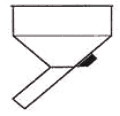APPLICATION OF MAGHAMMERS ON
SILOS, BINS, HOPPERS & CHUTES
The size of a Maghammer necessary to provide proper material flow depends upon the following: Hopper size, plate thickness, shape, mesh size of material to be extracted and moved, and percent of moisture content in the material.
Coarse and dry materials are easily moved. The same material considerably finer requires more impact force to produce the desired flow. Main problems eliminated are : ARCHING, RAT-HOLING, CAKING & BRIDGING. Maghammers are operated by a Controller and PLC.
Units operate up to 130 Degrees C.
The number and location of Maghammers is determined by the type and size of the application.
See Below for examples.

PARABOLIC HOPPERS
Hoppers of this shape should have the Maghammer mounted within 300mm of the outlet frame... much closer to the discharge area than on the other vessels. Mount on the centre line utilizing channel for mounting.

RECTANGULAR HOPPERS
Mount the same as above and on the centre line. One Maghammer will impact 2 sides of a hopper this shape, to a degree which is sufficient. If an additional Maghammer is required, a second unit can be mounted on the opposite side at a different height.

RECTANGULAR/CYLINDRICAL BINS WITH FLAT BOTTOM & CENTRE DISCHARGE
Mount the same as a Rectangular Hopper. A larger unit is suggested because of the superimposed load. This type of container is struck easily by the Maghammer as the hopper portion is smaller for the same quantity of material than where all the material is held in a hopper portion.

RECTANGULAR BINS WITH HOPPER BOTTOM
Bins with a flat bottom and centre discharge usually have dead material storage which forms a hopper type discharge. The Maghammer should be mounted on the side of the bin just above where the angle of repose intersects the sides. The impacts will prevent material from forming a material wall around the outside of the bin and reduce dead space to a minimum.

CONICAL HOPPERS
The Maghammer should be mounted directly to the hopper face about 1/3 of the distance from the discharge area. When two units are necessary, they should be mounted diametrically opposite but at a slightly different height and properly phased.

HOPPERS WITH VERTICAL SIDES
Maghammers should be mounted on the sloping portion of the hopper, opposite the vertical side. Is should be 1/3 or less from the discharge area to the top of the sloping side.

HOPPERS WITH CHUTE DISCHARGE
Maghammers must be mounted at the bottom of the hopper, next to the bottom side of sloping chute discharge. This will impact the hopper as well as the discharge chute.

WOODEN HOPPERS
Wooden hoppers can only be impacted on when a Steel frame is present, supporting the wooden hopper. If construction is supported on joists, then instructions apply as any steel hopper, providing a metal base plate is present and welded to the frame.


INCLINED CHUTES
Inhibited flow due to chutes not steep enough to produce easy flow of material, are benefited by use of Maghammers. One unit will usually handle 3000 – 4250mm length. The Maghammer should be mounted below the centre, so that the lower portion receives the most impact force When mounting, make allowances for adjustment, if necessary, in both directions. A slight position change may enhance the effectiveness of the unit.
On tubular chutes, the Maghammer is mounted on a channel shaped plate, clamped to the chute, as per manufacturer’s instructions.
When using many Maghammers on long chute lengths, Maghammers require to be mounted 600mm from discharge, and thereafter halfway between first and upper end of chute.



